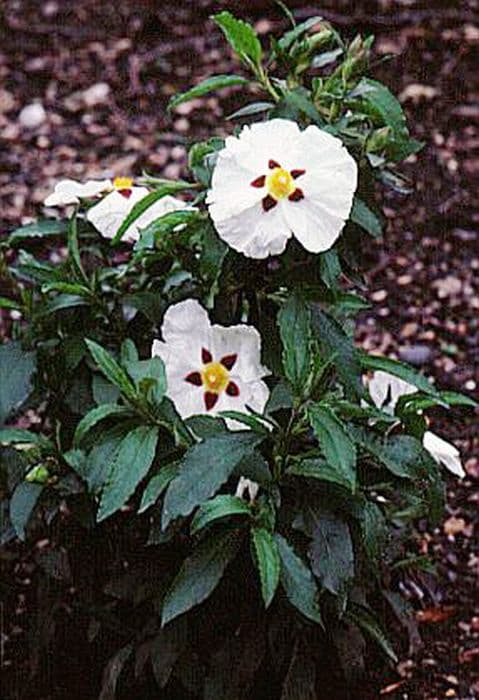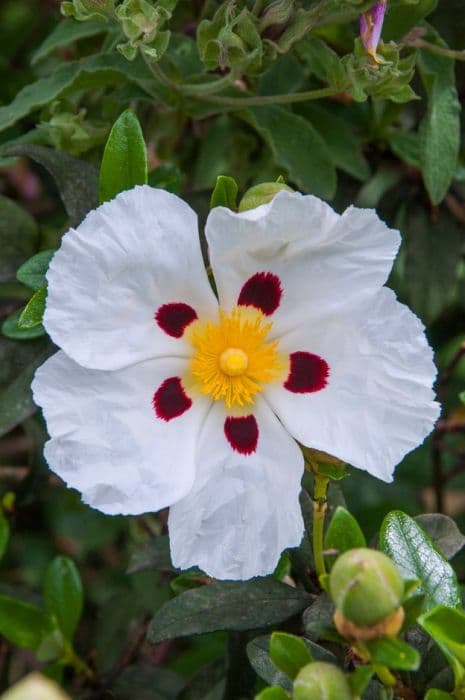Rock Rose × Halimiocistus 'Ingwersenii'

ABOUT
The plant known as × Halimiocistus 'Ingwersenii' is a hybrid garden plant that exhibits characteristics of both its parent species. It forms a low, bushy mound that is well-covered in evergreen foliage. The leaves are small, glossy, and oval-shaped, providing a dense, textural appearance. The color of the foliage is a deep green, which creates a striking contrast with the flowers when in bloom. The flowers are the most distinctive feature of this plant, which are large, showy, and have a saucer-like shape. These blossoms are white with a prominent yellow center, giving them a sunny, cheerful appearance. The petals are slightly crinkled, adding to their visual interest, and emerge from amongst the foliage to stand out vividly. The flowering season typically occurs in late spring to early summer, when the plant is awash with these attractive blooms. The stems of the plant are woody and tough, supporting the foliage and flowers well. The overall appearance of the plant suggests hardiness and the ability to withstand various garden conditions, while also providing aesthetic appeal through its distinctive foliage and blossoms.
About this plant
 Names
NamesFamily
Cistaceae
Synonyms
Rock Rose, Ingwersen's Variety, Ingwersen's Halimiocistus
Common names
× Halimiocistus 'Ingwersenii'.
 Toxicity
ToxicityTo humans
The Rockrose is not commonly known to be toxic to humans. If ingested, it is unlikely to cause any serious symptoms of poisoning. However, individual sensitivity could vary, and it's always best to avoid ingesting parts of ornamental plants as a general precaution. No significant consequences are typically expected from ingestion of the Rockrose.
To pets
The Rockrose is not known to be toxic to pets either. It is generally considered safe for dogs and cats, and ingestion should not lead to any serious symptoms of poisoning. As with humans, pets may have individual sensitivities, so it is wise to monitor your pet and prevent them from eating ornamental plants. No severe toxicity is associated with this plant in pets.
 Characteristics
CharacteristicsLife cycle
Perennials
Foliage type
Evergreen
Color of leaves
Green
Flower color
White
Height
3 feet (0.91 meters)
Spread
5 feet (1.52 meters)
Plant type
Shrub
Hardiness zones
8
Native area
Mediterranean
Benefits
 General Benefits
General Benefits- Drought Tolerance: Once established, it can survive with minimal watering, making it suitable for dry or drought-prone gardens.
- Low Maintenance: Requires minimal pruning and care once established, ideal for low-maintenance landscapes.
- Attracts Pollinators: Flowers provide nectar for bees and other pollinating insects, supporting local ecosystems.
- Ground Cover: Can spread to form a dense mat, reducing soil erosion and suppressing weed growth.
- Ornamental Value: Offers aesthetic appeal with its silver-green foliage and white flowers that have a yellow center.
- Seasonal Interest: Provides year-round interest with its evergreen foliage and flowers mainly in spring and summer.
- Tolerates Poor Soils: Can grow in poor soils, including sandy, loamy, or clay soils, as long as they are well-drained.
- Salt Tolerant: Suitable for coastal gardens as it can cope with salty air and soil conditions.
- Versatility: Can be used in rock gardens, borders, and as a general garden shrub.
 Medical Properties
Medical PropertiesThis plant is not used for medical purposes.
 Air-purifying Qualities
Air-purifying QualitiesThis plant is not specifically known for air purifying qualities.
 Other Uses
Other Uses- Photography Prop: Due to its aesthetic value, the Halimiocistus 'Ingwersenii', also known as Rock Rose, can be used as a background or accent in garden photography.
- Educational Tool: Horticulture students can study Rock Rose to learn about hybrid plants and cross-genus pollination methods.
- Art Inspiration: The vibrant flowers of Rock Rose can serve as inspiration for painters and illustrators focusing on botanical subjects.
- Textile Design: The patterns and colors of Rock Rose flowers can be used in textile design for creating nature-inspired fabrics.
- Theme Gardens: Rock Rose can be planted in thematic gardens focusing on hybrid plants or Mediterranean landscapes.
- Natural Dye Source: The petals of the Rock Rose can potentially be used to create natural dyes for small-scale fabric or craft projects.
- Wildlife Shelter: Dense shrubs like Rock Rose can offer nesting sites or shelter to small wildlife in the garden.
- Erosion Control: When planted on slopes or banks, Rock Rose can help stabilize soil and prevent erosion.
- Seasonal Celebrations: Its spring-to-summer blossoming can be used to mark seasons in rituals or seasonal celebrations in the garden.
- Culinary Presentation: Although not edible, petals of the Rock Rose could be used to decorate plates or platters for culinary presentations, as long as guests know not to consume them.
Interesting Facts
 Feng Shui
Feng ShuiThe plant × Halimiocistus 'Ingwersenii', commonly known as Rock Rose, is not used in Feng Shui practice.
 Zodiac Sign Compitability
Zodiac Sign CompitabilityThe Rock Rose is not used in astrology practice.
 Plant Symbolism
Plant Symbolism- Resilience: The × Halimiocistus 'Ingwersenii', or rock rose, is known for its ability to thrive in poor soils and resist drought, symbolizing the strength and resilience to endure and overcome challenging conditions.
- Beauty: With its lovely white flowers, the rock rose represents beauty and appreciation for the aesthetic, embodying the notion that there is beauty to be found in even the harshest environments.
- Survival: The rock rose's capability to survive in tough climates symbolizes the spirit of survival and the ability to persist through hardship.
 Water
WaterThe Halimium 'Ingwersenii', commonly known as Ingwersen's Halimium or Rock Rose, prefers a well-draining soil with dry to medium moisture. It should be watered deeply but infrequently, allowing the soil to dry out slightly between waterings. In general, provide about 1 inch of water per week, adjusting for rainfall. During the growing season, ensure a consistent watering schedule, but reduce the amount in winter when the plant is dormant. Be mindful not to overwater, as this can lead to root rot.
 Light
LightRock Rose thrives in full sun conditions, receiving at least six hours of direct sunlight daily. The ideal spot for your Halimium 'Ingwersenii' would be in a south-facing or west-facing garden where it can enjoy the bright light that promotes abundant flowering. If grown indoors, place it near a sunny window.
 Temperature
TemperatureIngwersen's Halimium does well in a range of temperatures, surviving minimum temperatures down to about 10°F and maximum temperatures that typical summer conditions would provide. The ideal temperature range for the plant is between 50°F and 70°F. Freezing temperatures can cause damage, so provide protection if needed.
 Pruning
PruningPruning the Rock Rose is generally done to maintain its shape and to promote a more compact, bushy growth. Prune it lightly after flowering, usually in late spring or early summer, to remove spent flowers and any dead or damaged branches. Avoid heavy pruning as it may not recover well.
 Cleaning
CleaningAs needed
 Soil
SoilRockrose 'Ingwersenii' thrives in well-drained, sandy or gritty soil with a pH that is slightly acidic to neutral. The best soil mix can be created with one part sand or perlite, one part garden soil, and one part compost. Ensure the compost is well-aged to avoid nutrient imbalances. The ideal soil pH for this plant ranges from 5.5 to 7.5.
 Repotting
RepottingRockrose 'Ingwersenii' is a low-maintenance plant that generally requires repotting only every 2 to 3 years. It's best to repot when the plant has outgrown its current pot or when the soil has degraded and needs refreshing. Use the recommended soil mix when repotting.
 Humidity & Misting
Humidity & MistingRockrose 'Ingwersenii' is adapted to a Mediterranean climate and tolerates dry air well. It does not require high humidity levels and will thrive in average room humidity, making it suitable for typical indoor environments. No specific humidity adjustments are necessary for this plant.
 Suitable locations
Suitable locationsIndoor
For Rockrose 'Ingwersenii', bright indirect light, dry air, minimal watering.
Outdoor
Plant in sun, well-drained soil, shelter from severe frost.
Hardiness zone
7-9 USDA
 Life cycle
Life cycle× Halimiocistus 'Ingwersenii', more commonly known as Ingwersen's variety of the rock rose hybrid, begins its life as a seed that germinates in spring under the right conditions of warmth and soil moisture. The seedling stage follows where roots establish and shoots emerge, growing into a small bush with silver-green leaves. During the growing season, it enters the vegetative stage, producing branches and leaves, and increasingly becomes a more substantial shrub. The plant reaches maturity in a few years and begins its reproductive phase, characterized by the blossoming of its saucer-shaped, white to pale yellow flowers with a prominent maroon blotch at the base of each petal, typically from late spring to summer. After pollination, usually by insects attracted to the flowers, it produces fruit in the form of a capsule containing seeds. The life cycle can repeat when these seeds are dispersed and successfully germinate, while the parent plant may live and continue to reproduce for many years if conditions are favorable.
 Propogation
PropogationPropogation time
Spring-Early Summer
Propogation: The × Halimiocistus 'Ingwersenii', commonly known as Halimiocistus 'Ingwersenii', can be propagated through semi-ripe cuttings during the late summer months. The most popular method for this plant involves taking cuttings that are about 4 to 6 inches (10 to 15 centimeters) long from healthy, non-flowering stems. The lower leaves are stripped off, and the cut end may be dipped in rooting hormone powder to encourage root development. The cutting is then planted in a well-draining potting mix, ensuring that the leafless part of the stem is buried. A clear plastic bag can be placed over the pot to maintain humidity, but it should be removed periodically to prevent mold growth. The pot should be kept in a warm, indirect light environment until roots have developed, which typically takes several weeks. Once rooted, the cutting can be transplanted into a larger pot or directly into the garden.









